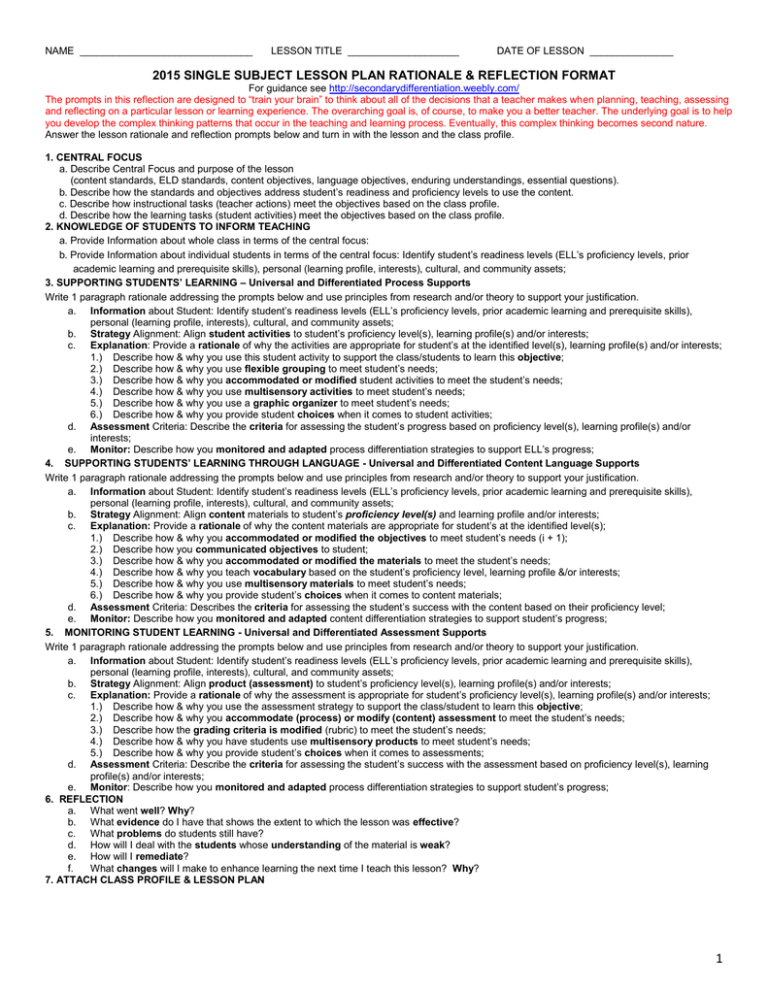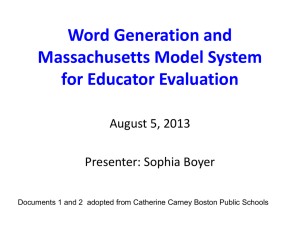File - Lesson Instructions
advertisement

NAME _______________________________ LESSON TITLE ____________________ DATE OF LESSON _______________ 2015 SINGLE SUBJECT LESSON PLAN RATIONALE & REFLECTION FORMAT For guidance see http://secondarydifferentiation.weebly.com/ The prompts in this reflection are designed to “train your brain” to think about all of the decisions that a teacher makes when planning, teaching, assessing and reflecting on a particular lesson or learning experience. The overarching goal is, of course, to make you a better teacher. The underlying goal is to help you develop the complex thinking patterns that occur in the teaching and learning process. Eventually, this complex thinking becomes second nature. Answer the lesson rationale and reflection prompts below and turn in with the lesson and the class profile. 1. CENTRAL FOCUS a. Describe Central Focus and purpose of the lesson (content standards, ELD standards, content objectives, language objectives, enduring understandings, essential questions). b. Describe how the standards and objectives address student’s readiness and proficiency levels to use the content. c. Describe how instructional tasks (teacher actions) meet the objectives based on the class profile. d. Describe how the learning tasks (student activities) meet the objectives based on the class profile. 2. KNOWLEDGE OF STUDENTS TO INFORM TEACHING a. Provide Information about whole class in terms of the central focus: b. Provide Information about individual students in terms of the central focus: Identify student’s readiness levels (ELL’s proficiency levels, prior academic learning and prerequisite skills), personal (learning profile, interests), cultural, and community assets; 3. SUPPORTING STUDENTS’ LEARNING – Universal and Differentiated Process Supports Write 1 paragraph rationale addressing the prompts below and use principles from research and/or theory to support your justification. a. Information about Student: Identify student’s readiness levels (ELL’s proficiency levels, prior academic learning and prerequisite skills), personal (learning profile, interests), cultural, and community assets; b. Strategy Alignment: Align student activities to student’s proficiency level(s), learning profile(s) and/or interests; c. Explanation: Provide a rationale of why the activities are appropriate for student’s at the identified level(s), learning profile(s) and/or interests; 1.) Describe how & why you use this student activity to support the class/students to learn this objective; 2.) Describe how & why you use flexible grouping to meet student’s needs; 3.) Describe how & why you accommodated or modified student activities to meet the student’s needs; 4.) Describe how & why you use multisensory activities to meet student’s needs; 5.) Describe how & why you use a graphic organizer to meet student’s needs; 6.) Describe how & why you provide student choices when it comes to student activities; d. Assessment Criteria: Describe the criteria for assessing the student’s progress based on proficiency level(s), learning profile(s) and/or interests; e. Monitor: Describe how you monitored and adapted process differentiation strategies to support ELL’s progress; 4. SUPPORTING STUDENTS’ LEARNING THROUGH LANGUAGE - Universal and Differentiated Content Language Supports Write 1 paragraph rationale addressing the prompts below and use principles from research and/or theory to support your justification. a. Information about Student: Identify student’s readiness levels (ELL’s proficiency levels, prior academic learning and prerequisite skills), personal (learning profile, interests), cultural, and community assets; b. Strategy Alignment: Align content materials to student’s proficiency level(s) and learning profile and/or interests; c. Explanation: Provide a rationale of why the content materials are appropriate for student’s at the identified level(s); 1.) Describe how & why you accommodated or modified the objectives to meet student’s needs (i + 1); 2.) Describe how you communicated objectives to student; 3.) Describe how & why you accommodated or modified the materials to meet the student’s needs; 4.) Describe how & why you teach vocabulary based on the student’s proficiency level, learning profile &/or interests; 5.) Describe how & why you use multisensory materials to meet student’s needs; 6.) Describe how & why you provide student’s choices when it comes to content materials; d. Assessment Criteria: Describes the criteria for assessing the student’s success with the content based on their proficiency level; e. Monitor: Describe how you monitored and adapted content differentiation strategies to support student’s progress; 5. MONITORING STUDENT LEARNING - Universal and Differentiated Assessment Supports Write 1 paragraph rationale addressing the prompts below and use principles from research and/or theory to support your justification. a. Information about Student: Identify student’s readiness levels (ELL’s proficiency levels, prior academic learning and prerequisite skills), personal (learning profile, interests), cultural, and community assets; b. Strategy Alignment: Align product (assessment) to student’s proficiency level(s), learning profile(s) and/or interests; c. Explanation: Provide a rationale of why the assessment is appropriate for student’s proficiency level(s), learning profile(s) and/or interests; 1.) Describe how & why you use the assessment strategy to support the class/student to learn this objective; 2.) Describe how & why you accommodate (process) or modify (content) assessment to meet the student’s needs; 3.) Describe how the grading criteria is modified (rubric) to meet the student’s needs; 4.) Describe how & why you have students use multisensory products to meet student’s needs; 5.) Describe how & why you provide student’s choices when it comes to assessments; d. Assessment Criteria: Describe the criteria for assessing the student’s success with the assessment based on proficiency level(s), learning profile(s) and/or interests; e. Monitor: Describe how you monitored and adapted process differentiation strategies to support student’s progress; 6. REFLECTION a. What went well? Why? b. What evidence do I have that shows the extent to which the lesson was effective? c. What problems do students still have? d. How will I deal with the students whose understanding of the material is weak? e. How will I remediate? f. What changes will I make to enhance learning the next time I teach this lesson? Why? 7. ATTACH CLASS PROFILE & LESSON PLAN 1


